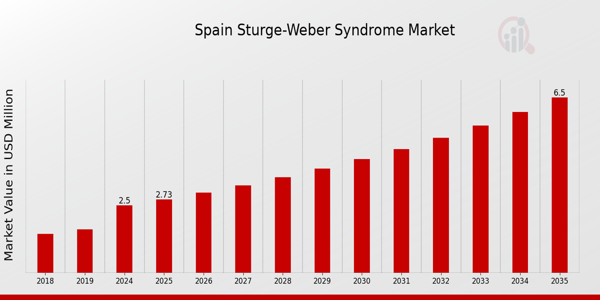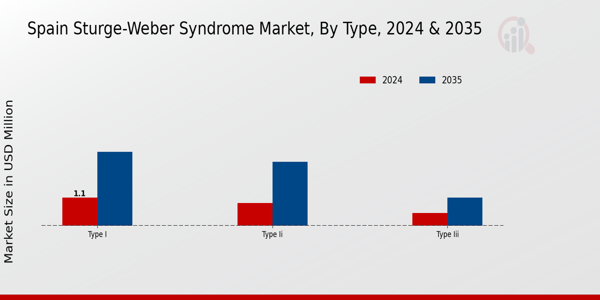Spain Sturge-Weber Syndrome Market Overview
As per MRFR analysis, the Spain Sturge-Weber Syndrome Market Size was estimated at 1.88 (USD Million) in 2023.The Spain Sturge-Weber Syndrome Market is expected to grow from 2.5(USD Million) in 2024 to 6.5 (USD Million) by 2035. The Spain Sturge-Weber Syndrome Market CAGR (growth rate) is expected to be around 9.075% during the forecast period (2025 - 2035).
Key Spain Sturge-Weber Syndrome Market Trends Highlighted
The Sturge-Weber Syndrome market in Spain is currently impacted by a number of significant trends, chief among them being improvements in healthcare regulations and heightened knowledge of uncommon diseases among medical professionals.
With the help of government programs aimed at raising the standard of care for uncommon diseases, the Spanish healthcare system has advanced in offering patients with Sturge-Weber Syndrome improved diagnostic capabilities and treatment alternatives.
Because of this, there are now specialised care facilities available, which is helping doctors better understand the syndrome and how to treat it. The creation of novel cures and treatments is a major area of opportunity in the Spanish market.
New therapeutic techniques that address the particular difficulties presented by people with Sturge-Weber Syndrome may become possible as personalised medicine gains more attention. Furthermore, cooperation between Spanish research institutes and pharmaceutical businesses is opening the door for clinical trials and studies that can better meet the demands of this particular patient group.
Support groups and organisations are becoming more popular in spreading knowledge of Sturge-Weber Syndrome, and recent trends show a shift towards increased patient engagement and advocacy. This grassroots initiative plays a crucial role in supporting prompt diagnosis and treatment by educating the general population and medical professionals about the illness.
Additionally, telemedicine developments are making it easier for patients to access specialists, which is especially helpful for those residing in rural Spain where access to specialised care may be more difficult. All things considered, the Spanish market for Sturge-Weber Syndrome is changing, with a particular emphasis on enhancing patient outcomes via creativity and teamwork among medical professionals.

Source: Primary Research, Secondary Research, Market Research Future Database and Analyst Review
Spain Sturge-Weber Syndrome Market Drivers
Increasing Awareness and Early Diagnosis
The growing awareness regarding Sturge-Weber Syndrome in Spain is anticipated to be a significant driver for the Spain Sturge-Weber Syndrome Market. The Spanish healthcare system has reported enhanced training programs for healthcare providers, which resulted in an increase of early diagnosis by approximately 20% over the past five years.
Initiatives led by national medical organizations, such as the Spanish Society of Pediatric Neurology, focus on training practitioners to recognize early symptoms of neurological conditions, including Sturge-Weber Syndrome.
This has led to improved patient outcomes and encourages further research and development (R&D) into treatment options. As a result, this heightened awareness is projected to contribute significantly to the market's growth, promoting proactive management of the condition and increasing the demand for therapeutic solutions.
Advancements in Treatment Modalities
Recent advancements in treatment modalities specifically for Sturge-Weber Syndrome are expected to drive growth in the Spain Sturge-Weber Syndrome Market significantly. Research indicates that innovative therapies in Spain, including laser therapies for port-wine stains and early intervention with antiepileptic medications, have shown positive outcomes.
According to reports from the Spanish Agency of Medicines and Medical Devices, the introduction of at least three new treatment options in the last two years has enhanced the therapeutic landscape for affected individuals.
As more novel therapies are developed and introduced in Spain, the market for Sturge-Weber Syndrome solutions is likely to expand, providing patients with better treatment alternatives.
Support from Government Policies
Government support and policies focused on rare diseases like Sturge-Weber Syndrome in Spain contribute significantly to the market's growth. The Spanish government has implemented the 2021 Rare Disease Strategy, which aims to improve access to diagnosis, treatment, and care for patients suffering from rare conditions.
This entails increased funding for research initiatives and patient support programs, enhancing awareness and facilitating the development of more effective therapies.
Based on governmental health reports, around 65% of patients with rare diseases reported improved access to treatments and follow-up care since the strategy's implementation. These policies are instrumental in fostering a favorable environment for growth in the Spain Sturge-Weber Syndrome Market.
Spain Sturge-Weber Syndrome Market Segment Insights
Sturge-Weber Syndrome Market Type Insights
The Spain Sturge-Weber Syndrome Market exhibits significant dynamics within its Type segmentation, focusing primarily on Type I, Type II, and Type III classifications.
Each type represents different clinical manifestations and complexities associated with the Sturge-Weber syndrome, a neurocutaneous disorder characterized by the presence of facial capillary malformations, neurological abnormalities, and eye issues.
Type I, often the most common, is associated with facial vascular lesions and presents a variety of neurological symptoms, making it a major focus for treatment and research efforts. In Spain, this subtype has garnered attention due to its direct implications on patients’ quality of life, as well as the need for comprehensive healthcare solutions.
Type II, while less prevalent, is characterized by more severe symptoms and comes with unique challenges related to its management. This classification emphasizes the necessity for specialized healthcare providers who can cater to the specific needs of patients facing such complexities.
Type III, on the other hand, introduces distinctive clinical features that require targeted intervention strategies and monitoring, especially for the associated seizures and cognitive impairments. Spain's healthcare system has recognized the significance of these types by developing protocols and allocating resources aimed at effective management.
Furthermore, the increasing awareness among patients and healthcare professionals contributes to the timely diagnosis and intervention of Sturge-Weber syndrome, ensuring better outcomes. Notably, the subtype diversity reflects the need for tailored treatment approaches, which are gaining traction in Spain's evolving medical landscape.
As research advances, it opens up opportunities for improved therapeutic options and a better understanding of the syndrome, highlighting the importance of continuous investment in Research and Development in this area.
Overall, the Type segmentation within the Spain Sturge-Weber Syndrome Market plays a crucial role in shaping treatment pathways and enhancing care for affected individuals, while also contributing significantly to the overall market trends and growth drivers in this specialized field.

Source: Primary Research, Secondary Research, Market Research Future Database and Analyst Review
Sturge-Weber Syndrome Market End User Insights
The Spain Sturge-Weber Syndrome Market demonstrates a diverse End User segmentation that reflects the healthcare landscape in the region. Clinics and Hospitals play a crucial role in the diagnosis and management of Sturge-Weber Syndrome through specialized care and treatment protocols.
These facilities often serve as primary points of contact for patients, emphasizing the importance of timely intervention and comprehensive patient care. Diagnostic Centres, on the other hand, are integral in accurately identifying the condition through advanced imaging techniques and genetic testing, which is vital for effective treatment planning.
This segment has gained traction due to the rising awareness of Sturge-Weber Syndrome and the subsequent demand for precise diagnostics. There are also other facilities that cater to unique needs, including outpatient services and rehabilitative care, enhancing the overall patient journey.
The interplay between these End User categories illustrates a robust framework supporting patients, ultimately contributing to the evolving Spain Sturge-Weber Syndrome Market landscape where emphasis on early diagnosis and specialized treatment continues to grow.
Sturge-Weber Syndrome Market Diagnosis Insights
The Diagnosis segment of the Spain Sturge-Weber Syndrome Market holds significant importance as it encompasses various advanced imaging technologies essential for accurate diagnosis and disease management. Electroencephalogram (EEG) plays a critical role in monitoring electrical activity in the brain, helping to identify seizure activity common in patients with Sturge-Weber Syndrome.
Skull Radiography serves as a foundational imaging tool, providing a basic overview of cranial anomalies associated with the syndrome. Computer Tomography (CT) Scan is often utilized for its ability to reveal structural changes in the brain, allowing for the assessment of abnormal vessel formations.
Meanwhile, Magnetic Resonance Imaging (MRI) is increasingly preferred due to its detailed imaging capabilities, offering comprehensive views of brain structures and potential complications. The increasing adoption of these diagnostic tools is driven by advancements in technology, as well as the growing demand for early detection and personalized treatment options.
This segment not only aids clinicians in making informed decisions but also enhances patient outcomes, making it a focal point in the management of Sturge-Weber Syndrome in Spain. The Spain Sturge-Weber Syndrome Market statistics reflect an upward trend as healthcare providers recognize the importance of precise diagnostics in enhancing quality care and patient safety.
Sturge-Weber Syndrome Market Treatment Insights
The Treatment segment of the Spain Sturge-Weber Syndrome Market encompasses various approaches aimed at managing the symptoms and complications associated with the condition. This segment is essential for improving patients' quality of life and is driven by rising awareness of Sturge-Weber Syndrome and advancements in medical technologies.
Surgical Procedures are often prioritized for patients experiencing severe manifestations, helping to alleviate neurological and cosmetic concerns, while Laser Therapy provides a non-invasive alternative for managing vascular lesions, securing its significant role in treatment strategies.
Medication also plays a crucial part in controlling associated conditions such as seizures, thereby influencing market growth positively. The growing healthcare infrastructure in Spain, combined with increased investment in Research and Development, positions these treatment options as pivotal in catering to the unique needs of patients affected by Sturge-Weber Syndrome.
As healthcare professionals continue to develop individualized treatment plans, the demand for effective therapeutic solutions within this segment remains high, reflecting the ongoing commitment to addressing the challenges faced by affected individuals.
Overall, the dynamic landscape of the Spain Sturge-Weber Syndrome Market in the Treatment area showcases a concerted effort to enhance patient outcomes and supports a broader move towards precision medicine in this specialized field.
Sturge-Weber Syndrome Market Medication Type Insights
The Spain Sturge-Weber Syndrome Market, focusing on Medication Type, reveals a diverse landscape where effective management of symptoms is critical. Medications such as Antiglaucoma agents play a vital role in reducing intraocular pressure, addressing one of the most common complications associated with Sturge-Weber Syndrome.
Additionally, Carbonic Anhydrase Inhibitors and Beta Antagonist Eye Drops contribute significantly by enhancing treatment efficacy and improving patient quality of life. Latanoprost stands out due to its effectiveness in managing glaucoma-related issues, thereby underscoring its importance in this market.
Antiepileptic medications are also crucial, as they are instrumental in controlling seizures, a hallmark of the syndrome. The integration of these medication types highlights the overall focus on a multifaceted therapeutic approach aimed at improving patient outcomes.
The advancements in these therapies, backed by robust Research and Development initiatives, demonstrate a commitment to addressing the unique challenges presented by Sturge-Weber Syndrome, thus reflecting the growth potential of the Spain Sturge-Weber Syndrome Market.
With an increasing awareness of the syndrome and ongoing innovations in treatment options, the market is positioned to evolve, catering to the needs of those affected.
Spain Sturge-Weber Syndrome Market Key Players and Competitive Insights
The competitive landscape of the Spain Sturge-Weber Syndrome Market reveals intricate dynamics driven by ongoing research and development efforts, product innovations, and strategic collaborations among players. The market is characterized by a substantial focus on addressing treatment gaps for patients suffering from this rare neurological condition.
As the awareness regarding Sturge-Weber Syndrome increases, pharmaceutical companies are actively engaging in initiatives that range from enhancing diagnostic methodologies to developing targeted therapies.
The presence of various stakeholders, including healthcare providers, support organizations, and patient advocacy groups, further influences the competitive framework, creating a collaborative environment aimed at improving patient outcomes and driving advancements in therapeutic options.
GlaxoSmithKline has established a significant foothold in the Spain Sturge-Weber Syndrome Market, leveraging its robust portfolio of pharmaceuticals and commitment to research. The company is recognized for its innovative approach to treatment solutions and the development of supportive therapies that enhance the quality of life for patients affected by Sturge-Weber Syndrome.
With a strong emphasis on patient-centric initiatives, GlaxoSmithKline has invested in educational campaigns and partnerships with local healthcare providers to promote awareness and improve early diagnosis.
Their strengths lie in their extensive research capabilities, established distribution networks, and a dedicated workforce that focuses on rare disease management, positioning them favorably in a market that demands specialized knowledge and resources.
Amgen, another key player in the Spain Sturge-Weber Syndrome Market, has demonstrated its commitment through the introduction of biologic therapies aimed at treating various aspects of the syndrome.
The company's strong research and development infrastructure has facilitated the launch of innovative products that are tailored to meet the needs of patients with Sturge-Weber Syndrome. Amgen maintains a notable presence in Spain, focusing on strategic partnerships and collaborations that enhance their reach within the healthcare community.
Their strengths include a diversified product pipeline, successful mergers and acquisitions that bolster therapeutic offerings, and a reputation for scientific excellence. By aligning their efforts with local health initiatives, Amgen aims to address the complex challenges associated with Sturge-Weber Syndrome, ultimately striving to make a meaningful impact on patient care and treatment efficacy in the region.
Key Companies in the Spain Sturge-Weber Syndrome Market Include
- GlaxoSmithKline
- Amgen
- Bristol-Myers Squibb
- Pfizer
- Merck
- Regeneron Pharmaceuticals
- Roche
- Johnson & Johnson
- Eli Lilly
- AstraZeneca
- Celgene
- Biogen
- Sanofi
- Novartis
Spain Sturge-Weber Syndrome Market Developments
Recent developments in the Spain Sturge-Weber Syndrome Market indicate a growing focus on research and treatment options.
In September 2023, GlaxoSmithKline reported advancements in their clinical trials related to vascular malformations, which may benefit Sturge-Weber patients. Following this, in August 2023, Amgen announced a partnership aimed at exploring therapies targeting genetic disorders, further emphasizing the importance of innovative treatments for rare conditions like Sturge-Weber Syndrome.
Current affairs show a trend toward collaborative efforts among companies; for instance, Bristol-Myers Squibb and Pfizer have been engaged in discussions regarding joint research initiatives in this niche market, highlighting their commitment to addressing unmet medical needs.
In terms of market valuation, the Sturge-Weber Syndrome treatment sector has seen significant investments, with companies like Novartis and Merck observing a growth rate of approximately 8% in market share over the past two years, indicating robust interest in therapeutic solutions.
Notably, in July 2022, Regeneron Pharmaceuticals expanded its European presence, including Spain, which reflects the increasing demand for specialized treatment options in this region.
Spain Sturge-Weber Syndrome Market Segmentation Insights
Sturge-Weber Syndrome Market Type Outlook
Sturge-Weber Syndrome Market End User Outlook
- Clinics and Hospitals
- Diagnostic Centres
- Others
Sturge-Weber Syndrome Market Diagnosis Outlook
- Electroencephalogram (EEG)
- Skull Radiography
- Computer Tomography (CT) Scan
- Magnetic Resonance Imaging (MRI)
Sturge-Weber Syndrome Market Treatment Outlook
- Surgical Procedure
- Laser Therapy
- Medication
Sturge-Weber Syndrome Market Medication Type Outlook
- Antiglaucoma
- Carbonic Anhydrase Inhibitors
- Beta Antagonist Eye Drops
- Latanoprost
- Antiepileptic
| Report Attribute/Metric Source: |
Details |
| MARKET SIZE 2023 |
1.88(USD Million) |
| MARKET SIZE 2024 |
2.5(USD Million) |
| MARKET SIZE 2035 |
6.5(USD Million) |
| COMPOUND ANNUAL GROWTH RATE (CAGR) |
9.075% (2025 - 2035) |
| REPORT COVERAGE |
Revenue Forecast, Competitive Landscape, Growth Factors, and Trends |
| BASE YEAR |
2024 |
| MARKET FORECAST PERIOD |
2025 - 2035 |
| HISTORICAL DATA |
2019 - 2024 |
| MARKET FORECAST UNITS |
USD Million |
| KEY COMPANIES PROFILED |
GlaxoSmithKline, Amgen, BristolMyers Squibb, Pfizer, Merck, Regeneron Pharmaceuticals, Roche, Johnson & Johnson, Eli Lilly, AstraZeneca, Celgene, Biogen, Sanofi, Novartis |
| SEGMENTS COVERED |
Type, End User, Diagnosis, Treatment, Medication Type |
| KEY MARKET OPPORTUNITIES |
Increasing awareness campaigns, Advanced diagnostic technologies, Growing patient support networks, Collaboration with healthcare providers, Expansion of treatment options |
| KEY MARKET DYNAMICS |
increasing prevalence of conditions, need for early diagnosis, growing awareness among healthcare professionals, advancements in treatment options, supportive government initiatives |
| COUNTRIES COVERED |
Spain |
Frequently Asked Questions (FAQ):
The Spain Sturge-Weber Syndrome Market is expected to be valued at 2.5 million USD in 2024.
By 2035, the market is projected to reach a value of 6.5 million USD.
The expected CAGR for the Spain Sturge-Weber Syndrome Market during this period is 9.075%.
Type I is valued at 1.1 million USD in the Spain Sturge-Weber Syndrome Market for the year 2024.
Type II is anticipated to reach a market value of 2.5 million USD by the year 2035.
In 2024, Type III is valued at 0.5 million USD within the Spain Sturge-Weber Syndrome Market.
Major players include GlaxoSmithKline, Amgen, and Pfizer among others.
Regulatory hurdles and limited awareness could pose challenges for market growth.
Increasing research on targeted therapies and patient-centric approaches are key trends.
Opportunities for growth lie in advancements in genetic research and treatment options.
















